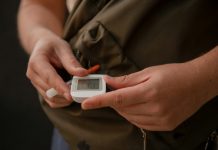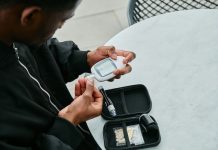
An estimated 25.8 million people in the United States are living with diabetes – but many still don’t understand the basics of the condition.
Over 8% of the population has diabetes, a condition where the body struggles to get energy from food.
Diabetes can affect a variety of organs and systems and complicate or lead to other serious health conditions.
“Diabetes is a chronic condition, so patients need to learn how to make managing their diabetes part of their everyday lifestyle,” says Emily Weatherup, director of the Michigan Medicine adult diabetes education program.
“The great news is that diabetes is very treatable and doesn’t need to stop anyone from living a normal, healthy life.”
Weatherup recently spoke about living with and managing diabetes during a livestream Q&A on Michigan Medicine’s social media channels. Below is a recap of some of the questions she and her team receive most frequently.
What is diabetes?
“Diabetes is a condition where the body struggles to get energy from the food you eat,” says Weatherup.
“In someone without diabetes, the energy, or glucoses in particular, from food is transported into cells and that energy is used to power everything, from your brain to your muscles to your heart pumping.
But in someone with diabetes, the body struggles to use that energy from the food consumed or to get that energy into the cells effectively.”
What is insulin and how does it relate to diabetes?
Insulin, produced in the pancreas, is the hormone that allows the body to use the glucose that’s just been digested.
“As digestion occurs, all the food gets sent into the bloodstream,” says Weatherup. “The glucose from the food travels where it needs to go via the bloodstream, and insulin basically takes it out of the blood and gets it into the cells. We really think of insulin as a key.
What is the difference between type 1 and type 2 diabetes?
Type 1 and type 2 diabetes are the predominant forms of diabetes. In type 1 diabetes, the body doesn’t make insulin at all.
People with type 2 diabetes produce some insulin, but the body doesn’t use it effectively.
“There could be problems with the amount of insulin being made, or the manner in which it’s being used,” says Weatherup.
What are the risk factors for diabetes?
There are a variety of risk factors that can put someone at risk for either type 1 or type 2 diabetes, including genetics.
“There is a small genetic component with type 1,” says Weatherup. “You are more likely to develop type 1 if you have a family member or direct relative with type 1. However, the genetic component is heavier with type 2.”
Being overweight or physically inactive can also put someone at a higher risk for developing type 2 diabetes. “You can’t control genetics, but you can control the modifiable risk factors associated with type 2,” Weatherup says.
What are the symptoms of diabetes?
Symptoms can vary, but for people who aren’t producing insulin or the insulin isn’t working properly to take sugar out of the blood, symptoms can include extreme thirst and urination, weight loss and fatigue.
“Usually blood sugar levels are very dangerously high when we see these symptoms,” says Weatherup.
However, people can develop diabetes without necessarily showing the symptoms above.
“There are people who have diabetes, but their blood sugars aren’t in the ‘danger zone’ level – they may not even know they have it,” says Weatherup. “Obesity and lack of physical activity increase the risk for developing type 2 diabetes in particular.”
How does someone get diagnosed with diabetes?
Diabetes is often diagnosed with an A1c test, which measures sugar stuck to the blood cells and gives an estimated average of blood sugar over the three months prior to testing.
“When that A1c number shows as elevated, that’s when a patient would be diagnosed with diabetes,” says Weatherup.
How is diabetes treated and managed? Is diabetes reversible?
Unfortunately, diabetes is not reversible. “Diabetes is a chronic condition, and it’s here to stay if you have it,” says Weatherup. “But it’s very manageable.”
People with type 1 diabetes must take insulin, either by a needle injection or insulin pump. Some patients with type 2 may also require insulin. Type 2 diabetes can sometimes manage their blood sugar with an oral agent, such as a pill.
She added that regardless of a type 1 or type 2 diagnosis, lifestyle changes or modifications are key to managing the condition effectively.
“People with diabetes generally need to be more aware of how things like their food choices, activity levels, and medications impact blood sugar levels, but this doesn’t stop anyone from leading a normal – just healthier – life.”
What is prediabetes?
Prediabetes refers to the development or slow progression toward type 2 diabetes. “While there are no preventative measures for type 1 diabetes, often times – though not all the time – type 2 can be prevented.”
A prediabetes diagnosis will typically come from a physician telling a patient they are at risk, and is officially classified with an A1c of 5.7-6.4% – blood sugar levels that are higher than the normal/ideal range, but not yet at the range where the patient would be diagnosed with type 2 diabetes.
Weatherup says being diagnosed with prediabetes can be a wake-up call.
“Once you have diabetes, it doesn’t go away. But if you are diagnosed with prediabetes, it is possible to make lifestyle changes that will prevent or significantly delay getting type 2 diabetes.”
What happens if diabetes isn’t properly managed?
“A lot of complications that can arise from poorly managed or unmanaged diabetes have to do with blood vessels,” says Weatherup.
“An excess of sugar in the blood can cause the blood to get very thick or sticky, which has vascular implications.”
These vascular, or blood vessel, implications can lead to increased risk for heart problems, as well retinopathy (eye damage) and neuropathy (nerve damage). “Managing blood sugar levels is key to avoiding potential complications.”
What does successfully managed diabetes look like?
Weatherup stresses that successful management will look different for each patient: “Great management really looks like what you want it to look like.
Patients should work with their physician and educators to develop realistic goals. There might be an A1c goal, or a weight goal. Medication adherence might be a goal.”
Weatherup also explains that diabetes is a self-managed disease.
“The patient living with diabetes is the one managing the diabetes. As we’ve said, there may be a lot of lifestyle changes that go into that management.
Typically, we want to be really specific and small with our goals, setting things that are achievable and can be built on moving forward. Well-managed diabetes is achieving – and sustaining – the goals you have set with your physician for your condition.”
In all, Weatherup stresses that diabetes, while chronic, is completely manageable and that with proper management, patients can have active, normal lives.
“Our job and our goal as health care providers and educators is to help people live with their diabetes, not live because of their diabetes,” she says. “Not live in fear of their diabetes, but truly live with this condition.”
Written by Amy Wiseman.



